

| 28-02-2016 (6244 ) | Categoria: Pain |
Tired of expensive equipment, health clubs, and exercise programs that only work for a while? You've come to the right place! It just took a little horse sense, penny-pinching, and that energy conservation that cowboys are noted for to come up with a sensible alternative. And it's FREE!
If you've found it difficult to stick with a good exercise program, give this one a try! I've used it for more than two decades... it's fairly easy to follow, doesn't take a major time commitment, and there's no equipment to buy. This plan started out as an adaptation of the excellent Royal Canadian Air Force fitness programs. I was spending a lot of time on the road, and wanted an exercise program I could even do in a motel room. This is the result...
Even if you are in reasonably good shape and health, please check with your doctor before starting this or any other exercise program. I've seen too many cases of "healthy" 19- or 20-year-olds who unexpectedly dropped dead while jogging or playing basketball!
Start out at a ridiculously easy level. When you begin, it should feel like you've done almost nothing. The old "No pain, no gain" motto is pure hog-wash. It's not the difficulty of an exercise that counts, it's the number of times you exercise the muscle. Getting a painfully sore muscle - or a hernia - does nothing to help get you in shape. A regular pattern of exercise that you can easily maintain - and enjoy - will do much more than a painful and short-lived program.
While exercising, wear loose-fitting clothing - preferably cotton. Take off your cowboy boots and wear comfortable shoes, such as walking shoes or sneakers. (The thin soles of western boots don't give enough cushioning for extensive walking or running. That's why a cowboy never walks if he can ride - it doesn't mean he's lazy.)
Do not exercise immediately after meals - wait at least half an hour after a snack and up to two hours after a large meal.
Remain at each level for at least three days - longer if the full count is difficult to do.
The first part of the exercise program can be done before you even roll out of your bunk in the morning. Let your alarm clock be your reminder that it's time to get in shape!
Horizontal series:
1a. Sit ups. You don't need a partner or anything else to hold your feet down for this one. Lie on your back, legs bent, feet together, hands resting palms down on knees. As you sit up, keep your arms straight and in contact with your knees. Lift with your lower back, following the line of your arm with your chin as you rise.
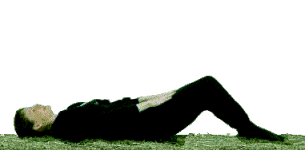
As you progress, you can move to the next level of difficulty on this one. If you don't have a partner, hook your feet under a sofa or bed to keep your feet down. Some fitness experts claim this is the best way to keep those saddle bags on your waist under control.
1b. Lie on your back, legs bent, feet together, hands clasped behind head. Sit up and twist to touch right elbow to left knee. Return to horizontal position. Repeat, touching left elbow to right knee to complete one cycle.
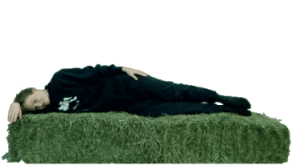 2. Side leg lifts. Lie on your right side, left leg above right leg, left arm lying on left leg, right arm comfortably in front of body on exercise surface. Lift left leg, hand remaining on leg and arm straight. Return leg to horizontal.
2. Side leg lifts. Lie on your right side, left leg above right leg, left arm lying on left leg, right arm comfortably in front of body on exercise surface. Lift left leg, hand remaining on leg and arm straight. Return leg to horizontal.
Roll to your other side and repeat the process, lifting the right leg.
 
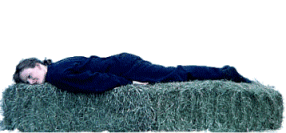 3. Back leg lifts. Lie face down, palms up under your thighs. Raise your head and one leg; repeat using the other leg. Keep your leg straight at the knee, thighs must clear your palms. (Count one each time second leg touches floor.)
3. Back leg lifts. Lie face down, palms up under your thighs. Raise your head and one leg; repeat using the other leg. Keep your leg straight at the knee, thighs must clear your palms. (Count one each time second leg touches floor.)
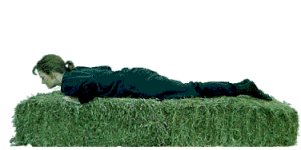 4a. Push-ups. Lie face down, hands under your shoulders, palms flat on the floor. Straighten your arms, lifting your upper body, but keeping your knees on the floor. Bend bend your arms to lower your body. Keep your body straight from the knees. Your arms must be fully extended and your chest must touch the floor to complete one movement.
4a. Push-ups. Lie face down, hands under your shoulders, palms flat on the floor. Straighten your arms, lifting your upper body, but keeping your knees on the floor. Bend bend your arms to lower your body. Keep your body straight from the knees. Your arms must be fully extended and your chest must touch the floor to complete one movement.
4b. Same as 4a, except the entire body is lifted, with only palms and toes on the floor. Keep your back straight. Your chest must touch the floor for each completed movement, after your arms have been fully extended.
 Vertical series:
Vertical series:1. Stretching. Feet apart, arms extended upward above head. Bend forward to floor, touching, then stretch upward and bend backward. Do not strain to keep your knees straight.
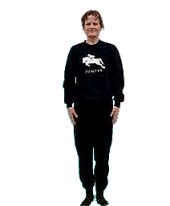 2. Standing leg lifts. (This is probably the single best exercise in the entire program! Although it looks like you are only working the leg you are lifting, you'll quickly discover that balancing on one leg gives a good workout to all of the muscles in the leg you're standing on - and even the back and abdominal muscles.) Stand with your legs together, arms at your sides. Slowly lift your right leg, balancing on your left, and return. Your left arm may move to help you keep your balance. Do the entire count with your right leg before shifting to do entire count again with your left leg.
2. Standing leg lifts. (This is probably the single best exercise in the entire program! Although it looks like you are only working the leg you are lifting, you'll quickly discover that balancing on one leg gives a good workout to all of the muscles in the leg you're standing on - and even the back and abdominal muscles.) Stand with your legs together, arms at your sides. Slowly lift your right leg, balancing on your left, and return. Your left arm may move to help you keep your balance. Do the entire count with your right leg before shifting to do entire count again with your left leg.
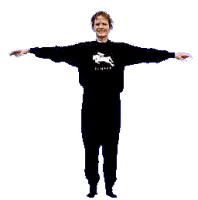 3. Arm swings. Standing with legs slightly apart, arms extended to sides horizontally, swing your arms toward the opposite side, right arm above left, bending elbows. Return to starting position, then repeat the exercise with left arm above right for one count.
3. Arm swings. Standing with legs slightly apart, arms extended to sides horizontally, swing your arms toward the opposite side, right arm above left, bending elbows. Return to starting position, then repeat the exercise with left arm above right for one count.
 4. Stationary run. Count a step each time your left foot touches the floor. Lift feet approximately four inches off floor. Run on the balls of the feet, keeping your heels off floor. After every 75 steps, do 10 "jumping jacks."
4. Stationary run. Count a step each time your left foot touches the floor. Lift feet approximately four inches off floor. Run on the balls of the feet, keeping your heels off floor. After every 75 steps, do 10 "jumping jacks."
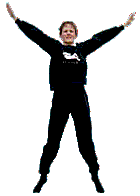 Jumping jacks - feet together, arms at side. Jump and land with feet astride and arms raised above head and touching. Return with a jump to the starting position for count of one. Keep arms straight. (Sorry, I don't have this one animated.)
Jumping jacks - feet together, arms at side. Jump and land with feet astride and arms raised above head and touching. Return with a jump to the starting position for count of one. Keep arms straight. (Sorry, I don't have this one animated.)
Try to breathe through your nostrils and exhale through your mouth. If you cannot maintain breathing through nostrils, then slow down.
After you complete your stationary run, cool down by walking around for a while until your breathing and heart rate return to near normal levels.
Stop exercising if you experience:
Chest pain, pain in the neck, teeth, arms, or jaw, irregularity of your pulse, shortness of breath, light-headedness or dizziness, excessive fatigue, any unusual joint, muscle, or ligament problems, nausea and/or vomiting, headache.
Afegeix-hi un comentari: